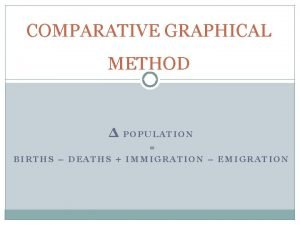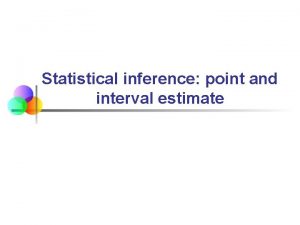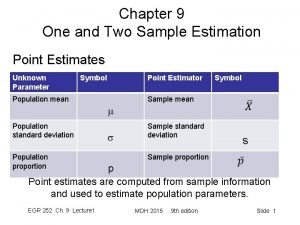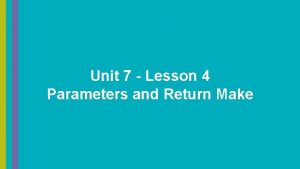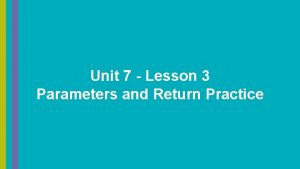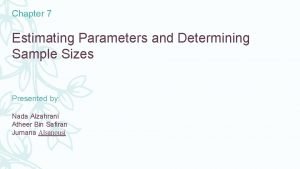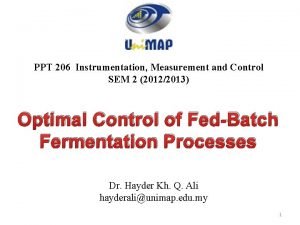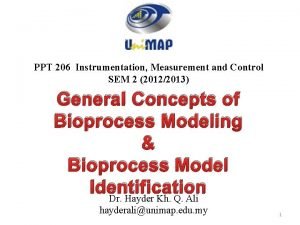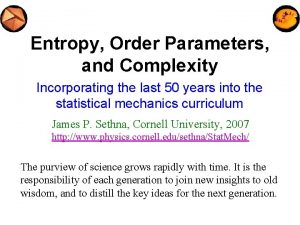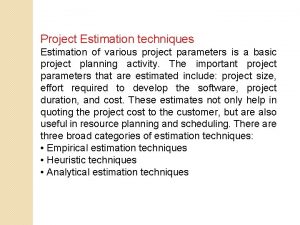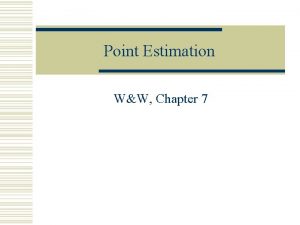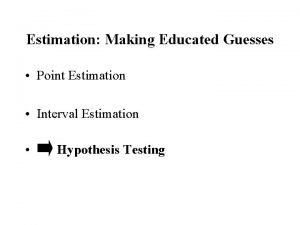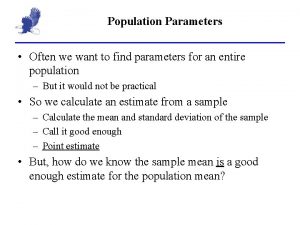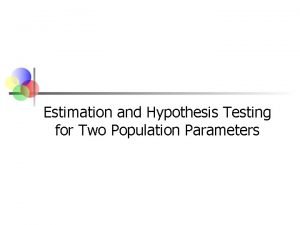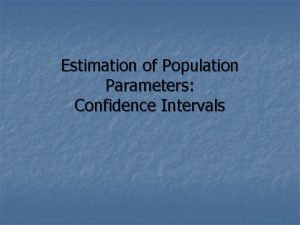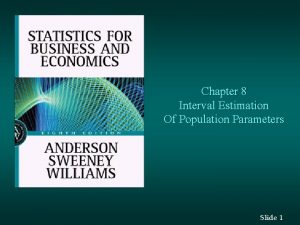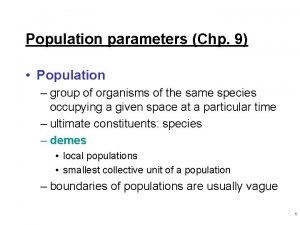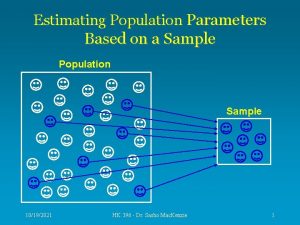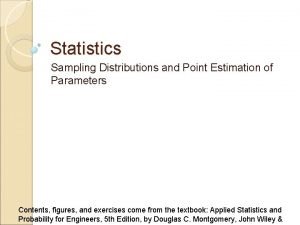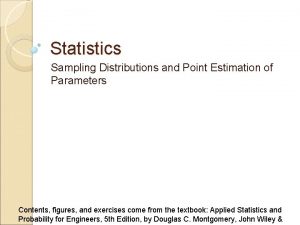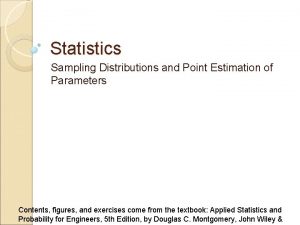Estimation of Various Population Parameters Point Estimation and




















- Slides: 20

Estimation of Various Population Parameters Point Estimation and Confidence Intervals Dr. M. H. Rahbar Professor of Biostatistics Department of Epidemiology Director, Data Coordinating Center College of Human Medicine Michigan State University

Important Statistical Terms • Population: A set which includes all measurements of interest to the researcher • Sample: Any subset of the population • Parameter of interest: Characteristics of interest in a population are called population parameters • (e. g, mean, standard deviation, proportion)

Inferential Statistics • Estimation includes point and interval estimation of population parameters • Mean = • Median • Standard deviation = • Proportion = p • Incidence

Central Limit Theorem • When large samples, (n>30), are selected from a population with mean and standard deviation , then • the sampling distribution of the sample mean is approximately normal with the same mean , and the standard error, SE=

Estimation of Population Mean A 95% confidence interval for based on a large sample, when n>30, is approximately,

Estimation of Population Mean A (1 - )100% confidence interval for based on a large sample, when n>30, is approximately,

Example # 1 Suppose we want to estimate the average birthweight of children born to non-smoking women in community X. Assume the standard deviation of birth-weights is 0. 5 Kg and the sample mean birthweight is 3. 0 Kg. Find a 95% confidence interval for .

Interpretation of CI’s What do we mean by (2. 9 Kg, 3. 1 Kg) is a 95% CI for the mean birth-weight of children born to non-smoking women in community X? Does interval (2. 9 , 3. 1) contain ?

Confidence Interval for P Suppose we want to estimate the prevalence of hypertension among adults in community X. Assume in a random sample of 100 adults from this community the prevalence of hypertension is 0. 50. Find a 95% confidence interval for P.

Probability vs Odds of an Event • An experiment is repeated for a large number of times. Then the probability of occurrence of an event E is the percentage of the time that particular event has occurred in repeated experiments. • Suppose P(E)=0. 40 • Odds of an event E =P(E)/{1 -P(E)}. Example, If P(E)=0. 40, then Odds of E=2/3.

In the following contingency table estimate the proportion and odds of drinkers among those who develop Lung Cancer and those without the disease?

Odds Ratio as a Measure of Association • QUESTION: Is there a difference in the proportion of drinkers among those who develop Lung Cancer and those without the disease? • Odds Ratio=ad/bc • OR=1. 67 • This means that the odds of drinking among cases is 67% more than the odds of drinking among controls.

Relative Risk as Measure of Association • QUESTION: Are persons exposed to “factor X” more likely to develop the disease than those not so exposed? Risk among exposed = a/(a+b) Risk among non-exposed = c/(c+d) Relative Risk = Risk among exposed relative to risk among non-exposed

QUESTION: Are persons exposed to “factor X” more likely to develop the disease than those not so exposed? Risk among exposed = a/(a+b)=33/60=0. 55 Risk among non-exposed = c/(c+d)=1667/3940=0. 42 Relative Risk = Risk among exposed relative to risk among nonexposed RR=1. 31

95% Confidence Intervals for Odds Ratios and Relative Risk • NOTE: • Confidence Intervals for Odds Ratios and Relative Risk are not symmetrical • Odds Ratio=ad/bc • OR=1. 67 • E. g. , 95% CI for OR (1. 2, 2. 9) • If the 95% CI for OR does not include one then we conclude a difference in the odds of drinking between the two groups • We use Statistical packages to calculate the CI’s for OR or RR

QUESTION: Estimate the difference between the proportions of drinkers among Lung Cancer cases and controls!

QUESTION: Estimate the difference between the mean blood levels of cases and controls?

Factors influencing the width of the CI’s Sample size Variance Confidence level = (1 - )100%

Width of the CI’s If Sample size =n , then Width If Variance , then Width If Confidence level , then Width

Choose ‘n’ to achieve the desired width for the CI’s
 Curvilinear method population estimation
Curvilinear method population estimation Chapter 4 population ecology test answer key
Chapter 4 population ecology test answer key Section 1 population dynamics answer key
Section 1 population dynamics answer key Population ecology section 1 population dynamics
Population ecology section 1 population dynamics Chapter 4 section 1: population dynamics
Chapter 4 section 1: population dynamics Inference point
Inference point Point estimation
Point estimation Hub-and-spoke vs point-to-point airlines
Hub-and-spoke vs point-to-point airlines Wvu stat 211
Wvu stat 211 Lesson 4 parameters and return make rock paper scissors
Lesson 4 parameters and return make rock paper scissors Lesson 3: parameters and return practice
Lesson 3: parameters and return practice What is the point estimate of μ?
What is the point estimate of μ? Lesson 3 parameters and return practice 8
Lesson 3 parameters and return practice 8 Extrinsic parameters of food
Extrinsic parameters of food Computer control of fermentation process ppt
Computer control of fermentation process ppt Hydraulic structures ppt
Hydraulic structures ppt Entropy order parameters and complexity
Entropy order parameters and complexity Block organization essay- examples
Block organization essay- examples How to calculate bubble point pressure
How to calculate bubble point pressure Point of difference and point of parity
Point of difference and point of parity One point perspective outside
One point perspective outside
